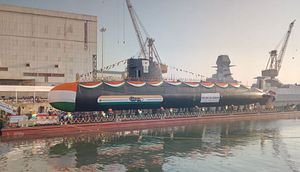The Indian Navy is refusing to commission the second Scorpene-class (Kalvari-class) diesel-electric attack submarine (SSK), the future INS Khanderi, until a total of 36 defects and deficiencies are addressed by Indian shipbuilder Mazagon Dock Limited (MDL) and its partner, French state-owned submarine builder Naval Group, formerly known as Direction des Constructions Navales Services (DCNS), according to local media reports. MDL is license-building the SSK in collaboration with France’s Naval Group in Mumbai.
The Indian Navy is insisting that MDL deliver a “fully sea- and battle-worthy” submarine and address “all outstanding snags and shortcomings,” a senior naval officer was quoted as saying by IHS Jane’s on June 17. The officer refused to provide many details regarding the cited deficiencies, but mentioned that one of the “principal drawbacks” is the “unacceptably high” engine and propeller noise level.
According to the Business Standard, 29 deficiencies require testing on a calm sea, which will prove difficult to achieve given the imminent beginning of the monsoon season in India. As a result, no testing will likely occur until the middle to the end of September. “Another four issues require the submarine be docked in a navy dockyard for testing,” the paper reports. “This runs up against an existing docking schedule that dockyards have already issued, involving numerous other warships.”
Overall, the induction of the future INS Khanderi may be delayed by up to a year.
The 1,565-ton conventionally powered submarine Khanderi was launched in January 2017 and commenced sea trials in July of the same year. Originally, the SSK was supposed to be commissioned already in 2017; however, various technical and logistical issues caused repeated delays. In May I summarized the armament and technical characteristics of the Kalvari-class:
Powered by two 1250 kW MAN Diesel Engines, the SSK’s operational range is around 6,500 nautical miles (12,000 kilometers). Each SSK is powered by 360 battery cells and a permanently magnetized propulsion motor for operation under water.
While the class will not be equipped with an air-independent propulsion (AIP) system for the time being, there are plans to retrofit the boats with a domestically designed and built AIP in the coming years.
The Kalvari-class will be armed with French-made Exocet SM39 anti-ship missile, a sea-skimming, subsonic, solid-fueled anti-ship missile with an estimated operational range of 50-70 kilometers, and heavy-weight torpedoes. Each submarine can carry up to 18 anti-ship missiles or heavy-weight torpedoes.
Notably, the Indian Navy does not possess modern heavyweight torpedoes for the Kalvari-class as of now.
Naval Group was awarded a $4.16 billion contract by the Indian government to build six SSKs for the Indian Navy in cooperation with MDL under the Indian Ministry of Defense’s Project-75 acquisition program. This January, the Defense Acquisition Council, the Ministry of Defense’s principal procurement body, approved the procurement of six additional SSKs under Project-75. Given the current induction rate, it appears unlikely that the Indian Navy will commission all six Project-75 SSKs by 2022, as originally planned by the service.































